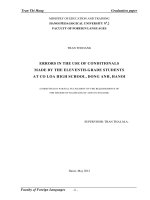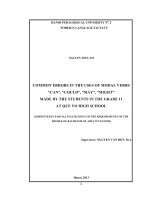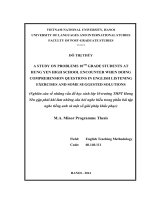SKKN figure out some common pronunciation mistakes by 10 grade students at xuan hoa high school AND SUGGEST SOME SOLUTIONS TO IMPROVE PRONUNCIATION TEACHING
Bạn đang xem bản rút gọn của tài liệu. Xem và tải ngay bản đầy đủ của tài liệu tại đây (123.64 KB, 15 trang )
SỞ GIÁO DỤC VÀ ĐÀO TẠO VĨNH PHÚC
TRƯỜNG TRUNG HỌC PHỔ THÔNG XUÂN HÒA
BÁO CÁO KẾT QUẢ
NGHIÊN CỨU, ỨNG DỤNG SÁNG KIẾNCẤP CƠ SỞ
Tên sáng kiến: “figure out some common pronunciation
mistakes by 10 grade students at Xuan hoa high school AND
SUGGEST SOME SOLUTIONS TO IMPROVE PRONUNCIATION
TEACHING”
Tác giả sáng kiến:Trịnh Thu Hường
Ngày sinh: 23/06/1983
Chuyên môn: Thạc sỹ Tiếng Anh
Table of content Mã sáng kiến: 376102
“figure out some common pronunciation mistakes by 10
grade students at Xuan hoa high school AND SUGGEST SOME
SOLUTIONS TO IMPROVE PRONUNCIATION TEACHING”
Abstract...........................................................................................................
Vĩnh phúc 2/2020
I. Introduction................................................................................................
1 .Pronunciation Description in Language Teaching and Learning
1.1.What is Pronunciation ?...........................................................................
1.2. Pronunciation errors
1.2.1 Sounds
1.2.2 Stress
2. What needs to be taught?
II .Research methodology
2.1. Subjects of the study
2.2. Instruments and procedure
2.3. Data Analysis Results
III. Main findings and discussion
IV. Suggested solutions
V. Conclusion
References.................................................................................................
Appendix ...................................................................................................
1. Introduction
In the economic integration process, English has become an important key to get a
good career. Understanding the importance of English, Vietnamese government has
paid more and more attention to teaching and learning English at High Schools.
The English textbooks give teachers a chance to teach all skills (Reading,
Speaking, Writing, Listening), instead of focusing on grammar like before. Now,
accurate pronunciation is very important. This helps students communicate English
better.
As an English teacher with more than 10 years of experience at a high school, the
author has found out that accurate pronunciation is basic but most of the students
have problems in pronunciation.
When teaching English for 10th grade students at Xuan Hoa High School, the
author of this research realised that many students feel less confident in their
speaking lessons for the reason of bad pronunciation. In order to improve the
quality of teaching and learning English, the author investigated the common
pronunciation mistakes by students and suggest some solutions to this problem.
Firstly, The recordings were used to examine the existence of students’ mistakes in
pronunciation. After that, the interviews were conducted to address the causes. A
total of 130 tenth grade students at Xuan Hoa High School took part in the survey.
From the answers of the students, the author stated that the tendency of students’
pronunciation mistakes were obvious. Based on the findings, the author proposed
some strategies for teachers and students to improve the quality of teaching and
learning pronunciation.
2. Name of the research:
“figure out some common pronunciation mistakes by 10
grade students at Xuan hoa high school AND SUGGEST SOME
SOLUTIONS TO IMPROVE PRONUNCIATION TEACHING”
3. The author:
- Họ và tên: Trịnh Thu Hường
- Địa chỉ tác giả sáng kiến: P. Đồng Xuân, Tx Phúc Yên, T.Vĩnh Phúc
- Số điện thoại:0975494883. E_mail:
4. The investor: ………………………………………………………………..
5. Field: Teaching methodology, focusing on solutions to improve the English
teaching quality, especially teaching writing skill.
6. Testing/ applied date: 9/ 2019
7. Description:
- Content:
“figure out some common pronunciation mistakes by 10
grade students at Xuan hoa high school AND SUGGEST SOME
SOLUTIONS TO IMPROVE PRONUNCIATION TEACHING”
Abstract
In the process of integration and globalization, English is rapidly becoming
an indispensable instrument in community communication. It is being used worldwide as the main language in business, trading, communication, etc. Therefore,
more and more people learn English as foreign language and wish to be able to
master it as their mother tongue. Learners cannot succeed in studying English
without mastering English pronunciation because pronunciation is one of the most
important components of a language. It is really very important for learners to have
communication of the target language as correct possible right from the start.
For high school students, they not only pay attention to pronounce correctly but
also want to know the mistakes and how to correct them. Though many studies
have been carried out on correct pronunciation, yet few studies have been done on
some common mistakes in English pronunciation alone. This minor study was
carried out with an attempt to investigate into difficulties in learning English
pronunciation for students at Xuan Hoa High School and find solutions for
teaching pronunciation. The methodology was used in the study including utilizing
questionnaires, interviews and class observation. The study was undertaken in
three classes with nearly 130 ten grade students at Xuan Hoa High School. The
results of the research showed that the students mainly find it difficult to
pronounce correctly, distinguish sounds, and use stress and intonation. The results
also showed a significant effect of teachers’ teaching methods on students’ attitude
and motivation towards learning pronunciation.
I.
Introduction
1. Pronunciation Description in Language Teaching and Learning
1.1. What is Pronunciation?
It is not easy to define exactly what pronunciation is. So far, many linguists
have given out their different definitions of it. Thus, we may come to accept the
following definition: “Pronunciation is the manner in which someone utters a
word” or “The standard way in which a word is made to sound when spoken; the
way in which a person sounds the words of a language when speaking”
1.2. Pronunciation errors
1.2.1. Sounds
+ / / is confused with /i/
Example: Seat/ sit Feet/ fit
Problem: Students can not differentiate short and long vowels. Long /i:/ is get
shortened as /i/.
+ / / is pronounced as /e/
Example: Bad/ bed Sad/set
Problem:
Students pronounce / / in the position that the tongue and jaw are only slightly
raised.
+ / / is pronounced / /
Example: Sport/ spot Court/ cot
Problem: There is no short and long vowel differentiation. Long / / is shortened as
/ / . This is also due to Vietnamese student’s habit of pronouncing the letter “o”. In
Vietnamese there is no long or short sound “o”
+ /u: / is pronounced as /u /
Example: Foot/ food
Hoot/ hood
Problem: There is no short and long vowel differentiation. Long /u: / is shortened
as /u/. This is also due to Vietnamese student’s habit of pronouncing the letter “u”.
In Vietnamese there is no long or short sound “u”
+ / / is confused with /s/
Example: Shake/ sake
Sheet/ seat
Problem: Speakers allow the air stream to flow over the sides of the tongue instead
of the middle and their mouth is not rounded when they pronounce / /
+ /d / is confused with /j /
Example: Just / yet
jelly / yell, July
Problem: The tongue slides too quickly to the next sound without touching the
alveolar
+ /d / is confused with / /
Example: Judge/ just virgin/ version
Problem: Vietnamese students do not often notice the difference between these two
sounds. Instead of inserting the sound /d / before making the sound / /, speakers
pronounce rightly from / /
+/ / is confused with /s /
Example: Thin / sin
thigh / sigh
Problem: In stead of putting the tongue between the teeth, speakers keep it right
behind the teeth when pronounce / /
+/ / is confused with /z /
Example: Then /zen
Problem: In stead of putting the tongue between the teeth, speakers keep their
tongue behind the teeth when pronounce / /
+/tr / is confused with /ch / in Vietnamese
Example: tray / chây trend / chen
Problem: / tr / included two sounds / t / and / r / which are pronounced fast and
gliding from
/ t / to / r /. But students often hear them as one sound and mispronounce them as /
ch /.
+/t / is confused with /ch / in Vietnamese
Example: Chuck / chắc
chick/ chích
Problem: By the habit of pronounce the sound / ch / in Vietnamese, students just
put the tip of the tongue behind the teeth instead of keeping it behind the alveolar
ridge with the mouth rounded.
+/k / is confused with /g / in Vietnamese
Example: Call/ côn
kite/ cai
Problem: Speakers use their voice to pronounce /k / like they always do with the
sound / g / in Vietnamese.
+/d / is pronounced as / đ / in Vietnamese
Example: Day/ đây
dead/ đét
Problem: There is no /d/ sound in Vietnamese, which leads to the fact that /đ / is
used to replaced. Vietnamese speakers do not often create any air burst when
pronouncing /d /, which makes it sounds heavier than / đ /.
+/ / is pronounced as /th / in Vietnamese
Example: thick/ thích thank/ thanh
Problem: This problem can be explained by the orthographic system of Vietnamese
in which the letter combination ‘th” is often pronounced as /th/ not / / .
+/t / is pronounced as /t / in Vietnamese
Example: take/ tếch
to/ tu
Problem: The tongue blade touches the alveolar ridge, the ridge immediately
behind the upper teeth. The voice is also used when Vietnamese/ t / is pronounced
while English / t / is voiceless.
I.2.2. Stress
Word stress is your magic key to understanding spoken English. Native speakers of
English use word stress naturally. Word stress is so natural for them that they don't
even know they use it. Non-native speakers who speak English to native speakers
without using it may encounter two following problems:
1. They find it difficult to understand native speakers, especially those
speaking fast.
2. The native speakers may find it difficult to understand them.
High school students in Vietnam often pronounce words without using stress
because there is no stress in Vietnamese. They always pronounce every word with
the equal force and that is the reason why they find it difficult to listen to the native
speakers and the tapes.
2.What needs to be taught?
First, pronunciation teaching has to be integrated with other aspects of
language (grammar, vocabulary, style, function, discourse) and other skills
(listening comprehension, speaking, reading, writing, with non-linguistic cues e.g.
gestures, facial expressions etc.), as an integral part of language teaching program
from the early stages till the achievement of intelligibility with the motto “frequent
practice makes perfects”, “little and often”.
Second, to achieve the intelligibility with satisfactory accuracy and fluency in
pronunciation, integrated with other language aspects and skills for successful
communication, items of pronunciation need to be isolated for practice in words,
phrases then reintroduced in their contexts (sentence, short texts etc.) for the
successful development of communication. This second principle serves the first
one.
In order to have good pronunciation students should be taught English
phonetics, they should know the consonant and vowel sounds, the organ of speech,
stress and even the differences between English and Vietnamese sounds.
Consequently, the purpose of this study is to investigate the difficulties in
learning English pronunciation for High School students. The major research
questions are as follows:
1. What are common pronunciation errors made by students at Xuan Hoa High
School?
2. How do teachers’ methods of teaching affect students’ motivation and attitude
toward learning pronunciation?
II .Research methodology
2.1. Subjects of the study
130 students from three classes at Xuan Hoa High School are the target
subjects of the study. They are both male and female students aged from sixteen or
eighteen and have been learning English at least four years at secondary schools.
Their knowledge of English and their English vocabulary are at an acceptable
level.
2.2 .Instruments and procedure
To obtain data for the study, two instruments were employed: survey
questionnaire and class observation. 130 students were delivered a sheet of
questionnaire and tick the answers that were true to them. Being High School
English teachers, I and my colleagues observed the students in their English classes
for several lessons. No students in the classes knew that they were being observed
and the lessons took place naturally.
2.3. Data Analysis Results
For the first question:
In your opinion, which parts of learning pronunciation are difficult?
Students’ opinions were presented in the table below
Categories
Sounds
Intonation
Number of students ( % )
78,7
10
Stress
Others
84,5
7,8
Table 1
The result revealed that there were two main parts of learning pronunciation
which students found difficult: Sounds (78.7%), Stress (84, 5%). A quite high rate
believed that aspects of stress would be the most difficult ones.
For the 4th question:
What do you do to improve your pronunciation?
Only 26,7% often listen to the tapes and CDs. 39,5% of students look up the
pronunciation of words when checking in dictionary because 76% of them don’t
know how to pronounce a word from its phonetic transcription. We also realized
that the numbers of students who take care of their pronunciation improvement is
very far from our expectations because there are only 14% watch TV and 13%
reading newspapers and magazines in English.
The result was showed in the below table.
Techniques
Number of students
(%)
Listening to the tapes and CDs
26,7
Checking words in phonetic transcription in 39,5
dictionary
Watching TV channels in English
Reading newspapers and magazines
14
13
Table 2
III. Main findings and discussion
In response to the two research questions, the results were shown in table 1
and table 2. The main parts of learning pronunciation that our students found
difficult to study respectively are: Sound, intonation and stress. The second finding
is that students didn’t know how to take advantages of techniques and other
sources of information to improve their English pronunciation. Additionally, most
of them were not taught about how to pronounce a word from its phonetic
transcription. The last interesting finding is that students found excited and
motivated towards learning pronunciation when teachers use visual aids, model
sentences with standard accent. From these findings, the study suggested that
teaching pronunciation requires teachers to deeply understand what students
‘difficulties are in order to design suitable activities. Below are some applicable
solutions
IV. Suggested solutions
From the findings of this study, much has to be done to make teaching and
learning English pronunciation better. Below are some suggested solutions on
various aspects that affect the results of teaching and learning pronunciation at
Xuan Hoa High School. Teaching can effectively deal with time and practice. The
more time we use to practice, the more improvements the learners get
Here are some suggested solutions
Getting students to perceive
The first thing that needs to be done is to check that the students can hear and
identify the sounds teacher wants to teach. The same goes for information, rhythm
and stress: can the students hear the difference between how a competent, or
native, speaker of the language says a word, phrase or sentence and how a foreign
student says it?
This can be done by requesting imitation; or seeing if the students can distinguish
between minimal pairs such as ship/sheep; man/men; or by contrasting acceptable
with unacceptable pronunciation through recordings or live demonstration.
Telling students what to do
The next stage for some students may be some kind of explicit exhortation: this is
what ought it to be. For sound formation it may be help actually to use a sketch of
the mouth, and to describe the pronunciation on of a sound in terms of lips, tongue,
teeth, etc. But for other aspects of pronunciation a brief explanation is sufficient,
followed by demonstration and invitation to imitate and practice.
Practicing correct pronunciation
When teacher is satisfied that the pronunciation point has been satisfactorily
perceived by students, teacher should advise them to come on to the stage of
practice: consolidating and establishing the habits of acceptable pronunciation
through exercises that provide repetition and reinforcement.
To sum up, the errors which are most important to correct are those which may
easily lead to lack of comprehension, or which make the speech “uncomfortable”
to listen to; by the same principle, errors which produce no comprehension
problems but simply make the speech slightly foreign sounding may not need
correcting.
V. Conclusion
In conclusion, this study focuses on under- research- topic; therefore, there is
no doubt about its notable contribution to the study of English speaking of either
students or English teachers. It provides readers with common pronunciation errors
in English that High School students may make. As few students can recognize
their own pronunciation errors and know how to rectify them. Moreover, this can
also be used as a reference for their student’s pronunciation errors and to suggest
some solutions
While conducting this study, I encountered a problem of lack of materials relating
to Vietnamese sounds and mistakes that Vietnamese students often make when
speaking English. Thus, there may be other pronunciation errors that I have not
fully comprehended.
Finally, to speak English correctly and appropriately, students are supposed not
only to study English sounds but English stress and intonation as well.
References
Precinton , Teaching pronunciation ,Volume 7, Asian EFL Journal.
Ur , P (1996 ) A course in language teaching, Cambridge: Cambridge University
Press
ELTTP Methodology Course, book 1, pp8- 13.
- Applying possibility:
I hope that this study can partly help English teachers not only in Vinh Phuc but
also other provinces find a new way in improving students’ pronunciation and help
the teacher find out the better teaching method to teach pronunciation. Being one
of the teachers at Xuan Hoa High School, I can clearly see the present problem of
students’ pronunciation mistakes which is one of Xuan Hoa High School students’
and teachers’ challenges. The results of the research showed that the students
mainly find it difficult to pronounce correctly, distinguish sounds, and use stress
and intonation. The results also showed a significant effect of teachers’ teaching
methods on students’ attitude and motivation towards learning pronunciation.
On the part of teachers, they can help their students to better their pronunciation by
check that the students can hear and identify the sounds teacher wants to teach and
to describe the pronunciation on of a sound in terms of lips, tongue, teeth followed
by demonstration and invitation to imitate and practice.
On the part of students, they can come on to the stage of practice: consolidating
and establishing the habits of acceptable pronunciation through exercises that
provide repetition and reinforcement to improve English proficiency.
This study focuses on under - research- topic, therefore, there is no doubt about its
notable contribution to the study of English writing of either students or English
teachers. It provides readers with the common pronunciation mistakes that High
School students may get. Moreover, this can also be used as a reference for the
English teachers to improve their teaching method
8. Confidential information:
.....................................................................................................................................
9. The condition for the research to be applied
This study can be applied in all high schools not only in Vinh Phuc but also in
other provinces where English is being taught.
10. The initiative’s benefits
From the author’s point:
This study is done in the hope of finding out the common pronunciation mistakes
and contributing some recommended strategies for students to better the
pronunciation.
From the findings the author gave some suggested solutions with view to
improving the quality of teaching and learning pronunciation.
.....................................................................................................................................
11. Applied by:
No Organizations Address
1
Field
Xuan Hoa HighXuan Hoa – Phuc Yen –Teaching Methodology
School
Vinh Phuc
2
............., ngày.....tháng......năm......
Xuân Hòa, ngày 15 tháng 2 năm2020
Thủ trưởng đơn vị/
Tác giả sáng kiến
Chính quyền địa phương
(Ký, ghi rõ họ tên)
(Ký tên, đóng dấu)
Trịnh Thu Hường









